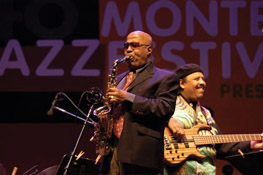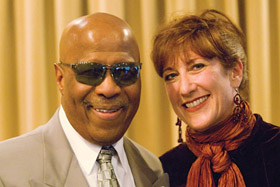By Andrew Gilbert

In 2005, 40 years after his triumphant debut at the Monterey Jazz Festival, saxophonist John Handy returned to the same stage, this time with musician Carlos Reyes, to blow the audience away again. — Photo by Stuart Brinin
One of the most innovative and visionary saxophonists in postwar jazz, John Handy (B.A., '63) has been a creative force for half a century.
From his work with bass titan Charles Mingus in the 1950s and his triumph at the 1965 Monterey Jazz Festival to his pioneering world music collaborations with Indian sarod legend Ali Akbar Khan and his hit 1976 R&B album "Hard Work," Handy has blazed a brilliant trail as an improviser, composer and bandleader.
He spent many of his formative years at SF State and attained a first-rate musical education, training that he put to inspired use, particularly as a composer. "If Only We Knew," a composition that began as a class project at SF State, and "Spanish Lady" both earned Handy Grammy nominations. As a young music student, he perfected his craft on the bandstand. Between classes, Handy played sax at the city's Fillmore nightclubs with the likes of Ella Fitzgerald, Sammy Davis, Bill Epstein and Buddy Rich.
Handy's relationship with his alma mater continued long after he graduated. As a lecturer, he distinguished himself with his effectiveness and generosity in the classroom.
After he retired, Handy was invited back as an artist-in-residence, honored with two jazz festivals in his name and just last year, inducted into SF State's Alumni Hall of Fame. At the ceremony, alto saxophonist and SF State Music Lecturer Andrew Speight noted that before Handy graduated, he was already esteemed by jazz masters Charles Mingus, Miles Davis and John Coltrane, an accomplishment all the more impressive, Speight said, because jazz was not yet widely accepted as a major musical genre. "The whole time he was sitting there working and practicing his craft, becoming a great musician ? that other musicians aspire to be like, he was having to do it under the table, out of the room, not letting people know," Speight said. "He played clarinet. He didn't play jazz. He played the legitimate music of the day, which was classical music."
Professor Dee Spencer, who founded the undergraduate jazz studies degree program in 1990 as part of SF State's School of Music and Dance, says, "John's a pioneer, and has always been ahead of his time. He was doing world music before we called it that. He was playing jazz/funk back in 1976. Whenever I want to know what's going to happen next in jazz I say, ?What's John Handy doing?'"
Relaxing in the living room of the Oakland Hills house he shares with his wife Del, Handy winces occasionally from a back injury he suffered while playing a pickup game of football in the Army in 1953. With his shaved head and dark shades, he looks a good decade younger than his 74 years, like central casting's first call for a cool jazz cat role. He comes across as warm and genuine, with a keen emotional receptivity that sears through his alto saxophone.

One of John Handy's former students, jazz vocalist Kitty Margolis (right), recalls that he "imparted the dignity, the joy and the cultural importance of jazz in world music. He gave his students an intimate glimpse into this quintessential American art form from a master insider's perspective." — Photo by Gino de Grandis
Born in Dallas on Feb. 3, 1933, Handy (no relation to "Father of the Blues" W.C.) spent his childhood in Texas. He had recently devoted himself to the saxophone when his family relocated to Oakland in the late 1940s. Attending McClymond High School, he quickly established himself as one of the most promising young players on the scene, holding his own with musicians two and three times older.
After he enrolled at the University, Handy started playing clarinet in the SF State Concert Band, then one of the most respected in the country. He remembers that first year, when he took classes by day and played gigs at night, as one of the happiest times in his life. "I was playing six nights a week," he says, recalling the difficult trip to his morning biology class with Professor Joel Gustafson. "I didn't have a car, so I got there whenever the M streetcar arrived. They finally gave me a seat right near the door. I was coming in with a suit, tie, saxophone and an armful of books."
With the Central Avenue scene in Los Angeles rapidly declining, many Southern California-based musicians started heading north, and Handy became close with several L.A. transplants, including Frank Morgan, another teenage alto sax phenomenon, and Sonny Clark, a brilliant young pianist. Unfortunately, like many jazz musicians in the years after World War II, they were both hooked on heroin, an addiction that killed Clark at the age of 31 and derailed Morgan's career for decades. It was a trap that Handy avoided. "When I'd finish classes I'd go to their apartment and wake them up," Handy says. "They'd get up and fix. I saw that two times and I said, ?No, not for me.'"
Just as he was really settling into student life, however, he was drafted, and spent two years in the Army overseas, mostly in Japan. He was on furlough in 1955 when he received sad news. "I was home a few days and Charlie [?Bird'] Parker died," he recalls. "A cold rainy March, trying to get used to my surroundings and my hero died. It was very depressing. Guys weren't doing great in those days, the music was hurting."
After he was discharged from the service, he spent two years at City College of San Francisco before returning to SF State and completing his degree. He made a strong impression on faculty members, including Roger Nixon, with whom he studied composition. "John was definitely a free spirit and I had great empathy for that," Nixon says. "What we were trying to do was give him enough composing craft to realize his musical ambitions, which he certainly did. He was very devoted to his craft and his style, and I was very impressed with his ability."
Handy moved to the East Coast in the summer of 1958 and quickly gained attention through his work with trumpeters Kenny Dorham and Idrees Sulieman, who introduced him to pianist Randy Weston. Already a highly respected composer, Weston was starting to incorporate African influences into his tunes. Handy played a 20-week run with him at New York's legendary Five Spot, and a tight friendship was forged. In the fall of 1958, Handy recorded his first album as a leader, "In the Vernacular," a session for Roulette featuring piano great Roland Hanna and drum legend Roy Haynes. But it was the year he spent with the volatile bassist/composer Charles Mingus that made Handy's national reputation.
On the liner notes to the classic Columbia album "Mingus Ah Um," Mingus claimed that he discovered the alto player at the Five Spot, where the musicians on the bandstand wouldn't let Handy sit in because he looked too square. The truth is that Handy had sat in for half the set before Mingus arrived. "During the break he yelled to the stage so practically everyone in the place could hear him, ?Hey man, why don't you let this guy sit in?'" Handy recalls. "I wanted to be heard so I got up again and played my ass off. He ran out of the club banging the double saloon doors, shouting, ?Man, Bird's back!'"
Though his relationship with Mingus was prickly, Handy's powerful sound, combining the rhythmic agility of bebop with the soaring lyricism of Johnny Hodges and the extroverted blues sensibility of Earl Bostic, fit perfectly into Mingus' compositional framework. It was one of Mingus' most prolific periods, and within less than a year Handy contributed to several epochal sessions, including "Mingus Dynasty" on Columbia, "Blues and Roots" on Atlantic and the underrated "Wonderland" on Blue Note.
Meanwhile, Handy found out that SF State's records did not include work he had done for two incompletes, and he returned to finish the course work. In the end, the Bay Area can thank SF State for bringing Handy back to the West Coast. His career took off when he created a sensation at the 1965 Monterey Jazz Festival with his exceptional quintet featuring violinist Michael White and guitarist Jerry Hahn. Signed to a contract with Columbia, he recorded four albums with the band and created some of the most distinctive music of the period by blending avant-garde influences with hard bop.
"One thing that's important to understand is that John extended the range of the horn in such a lyrical and melodic way that it's authentically his own," says Hafez Modirzadeh, an associate professor of music at SF State. "I don't know of any saxophonist who can compare in the altissimo range. We still can't figure out how he does it. His orchestrating for small groups was also very interesting. He had a gift for bringing together the innovations of his time, like modal scales, and making them very accessible and exciting for audiences."
By the late 1960s, SF State was looking to broaden its curriculum; Handy was hired to teach a jazz history class. He brought the message of jazz to SF State students for more than a decade, often having to turn many away from the popular course. Former student Muata Kenyatta says he was thrilled to "meet a lot of cats in Handy's class," which featured performances by a dazzling array of Handy's colleagues, including the Bill Evans Trio, Herbie Hancock's band with Joe Henderson, the Charles Mingus Sextet and Sun Ra. At the same time, Handy was forging new musical paths by collaborating with Ali Akbar Khan, an unsurpassed master of the Indian lute known as a sarod.
It was a partnership that led the teenage percussion master Zakir Hussain, to move to the Bay Area. "John and I did duo tours, and I would marvel: this guy's blowing for an hour, and there's no bass, no drums, no piano, nothing to relieve him," Hussain recalls. "He was so amazing. He would sit down on the floor cross-legged and play with us. He was the first non-Indian in this part of the world who I played with and it was a great learning experience."
In 1999, the University launched its Jazz and World Music Studies program. Today SF State student musicians focus on a range of instruments, including the Persian santour, Arabic oud and accordion. "We emphasize the oral and improvised traditions that jazz shares with non-Western cultures," Modirzadeh says. "And you can trace that right back to John. He played cross-culturally. He promoted that concept that the improvised traditions of the world have a common ancestry ? he's living history."
To hear John Handy in action, visit his listening room at www.johnhandy.com
SF State Cats Past, Present and Future
Harlem of the West, the Fillmore Jazz Era